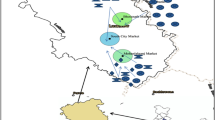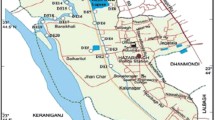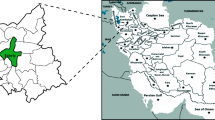Abstract
Contamination of heavy metals in fish and vegetables is regarded as a major crisis globally, with a large share in many developing countries. In Bogra District of Bangladesh, concentrations of six heavy metals, i.e., chromium (Cr), nickel (Ni), copper (Cu), arsenic (As), cadmium (Cd) and lead (Pb), were evaluated in the most consumed vegetables and fish species. The sampling was conducted during February–March 2012 and August–September 2013. The levels of metals varied between different fish and vegetable species. Elevated concentrations of As, Cd and Pb were observed in vegetable species (Solanum tuberosum, Allium cepa and Daucus carota), and fish species (Anabas testudineus and Heteropneustes fossilis) were higher than the FAO/WHO permissible limits, indicating these three metals might pose risk from the consumption of these vegetable and fish species. The higher concentration of heavy metals in these vegetable species might be due to the higher uptake from soil and sediment ingestion behavior in fish species. Multivariate principal component analysis (PCA) showed significant anthropogenic contributions of Cr, Ni, Cu and Pb in samples as the PCA axis scores were correlated with scores of anthropogenic activities. Target hazard quotients showed that the intakes of Cu, As and Pb through vegetables and fish were higher than the recommended health standards, indicated non-carcinogenic risk. Therefore, intakes of these elements via fish and vegetables for Bangladeshi people are a matter of concern.



Similar content being viewed by others
References
Abbasi MA, Iqbal J, Khan MA, Shah MH (2013) Health risk assessment and multivariate apportionment of trace metals in wild leafy vegetables from lesser Himalayas, Pakistan. Ecotoxicol Environ Saf 92:237–244
Ahmad MK, Islam S, Rahman S, Haque MR, Islam MM (2010) Heavy metals in water, sediment and some fishes of Buriganga River, Bangladesh. Int J Environ Res 4:321–332
Ahmed MK, Parvin E, Islam MM, Akter MS, Khan MS, Al-Mamun MH (2014) Lead and cadmium induced histopathological changes in gill, kidney and liver tissues of freshwater climbing perch Anabas testudineus (Bloch, 1792). Chem Ecol 30:532–540
Ahmed MK, Shaheen N, Islam MS, Al-Mamun MH, Islam S, Mohiduzzaman M, Bhattacharjee L (2015a) Dietary intake of trace elements from highly consumed cultured fish (Labeo rohita, Pangasius pangasius and Oreochromis mossambicus) and human health risk implications in Bangladesh. Chemosphere 128:284–292
Ahmed MK, Shaheen N, Islam MS, Al-Mamun MH, Islam S, Banu CP (2015b) Trace elements in two staple cereals (rice and wheat) and associated health risk implications in Bangladesh. Environ Monit Assess 187:326–336
Alam MG, Snow ET, Tanaka A (2003) Arsenic and heavy metal contamination of vegetables grown in Samta village, Bangladesh. Sci Total Environ 308:83–96
Alhashemi AH, Sekhavatjou MS, Kiabi BH, Karbassi AR (2012) Bioaccumulation of trace elements in water, sediment, and six fish species from a freshwater wetland, Iran. Microchem J 104:1–6
Bean H, Schuler C, Leggett RE, Levin RM (2010) Antioxidant levels of common fruits, vegetables and juices versus protective activity against in vitro ischemia/reperfusion. Int Urol Nephrol 42:409–415
Bhuiyan MAH, Suruvi NI, Dampare SB, Islam MA, Quraishi SB, Ganyaglo S, Suzuki S (2011) Investigation of the possible sources of heavy metal contamination in lagoon and canal water in the tannery industrial area in Dhaka, Bangladesh. Environ Monit Assess 175:633–649
Burger J, Gochfeld M (2005) Heavy metals in commercial fish in New Jersey. Environ Res 99:403–412
Das HK, Mitra AK, Sengupta PK, Hossain A, Islam F, Rabbani GH (2004) Arsenic concentrations in rice, vegetables, and fish in Bangladesh: a preliminary study. Environ Int 30:383–387
Fang Y, Sun X, Yang W, Maa N, Xin Z, Fu J, Liu X, Liu M, Mariga AM, Zhu X, Hu Q (2014) Concentrations and health risks of lead, cadmium, arsenic, and mercury in rice and edible mushrooms in China. Food Chem 147:147–151
FAO (2006) Arsenic contamination of irrigation water, soil and crops in Bangladesh: risk implications for sustainable agriculture and food safety in Asia. Food and agriculture organization of the United Nations regional office for Asia and the Pacific, Bangkok, Thailand
FAO/WHO (2002) Codex Alimentarius- General standards for contaminants and toxins in food. Schedule 1 maximum and guideline levels for contaminants and toxins in food. Joint FAO/WHO food standards programme, Codex Committee, Rotterdam. Reference CX/FAC 02/16
FAO/WHO (2011) Joint FAO/WHO Food Standards programme Codex committee on contaminants in foods. Food CF/5 INF/1, pp 1–89
FAO/WHO (2004) Safety evaluation of certain food additives and contaminants. WHO food additives series no. 52. World Health Organization, Geneva
Forti E, Salovaara S, Cetin Y, Bulgheroni A, Tessadri R, Jennings P, Pfaller W, Prieto P (2011) In vitro evaluation of the toxicity induced by nickel soluble and particulate forms in human airway epithelial cells. Toxicol in Vitro 25:454–461
Gupta A, Rai DK, Pandey RS, Sharma B (2009) Analysis of some heavy metals in the riverine water, sediments and fish from river Ganges at Allahabad. Environ Monit Assess 157:449–458
HIES (household income and expenditure survey) (2011) Preliminary report on household income and expenditure survey-2010. Bangladesh Bureau of Statistics, Statistics division, Ministry of planning, Dhaka
Iqbal J, Shah MH (2011) Distribution, correlation and risk assessment of selected metals in urban soils from Islamabad, Pakistan. J Hazard Mater 192:887–898
Islam MM, Halim MA, Safiullah S, Hoque SAMW, Islam MS (2009) Heavy metal (Pb, Cd, Zn, Cu, Cr, Fe and Mn) content in textile sludge in Gazipur, Bangladesh. Res J Environ Sci 3:311–315
Islam MS, Ahmed MK, Al-Mamun MH, Hoque MF (2014a) Preliminary assessment of heavy metal contamination in surface sediments from a river in Bangladesh. Environ Earth Sci 73:1837–1848
Islam MS, Ahmed MK, Al-Mamun MH (2014b) Determination of heavy metals in fish and vegetables in Bangladesh and health implications. Hum Ecol Risk Assess Int J 21:986–1006
Islam MS, Ahmed MK, Al-Mamun MH (2015a) Metal speciation in soil and health risk due to vegetables consumption in Bangladesh. Environ Monit Assess 187:288–302
Islam MS, Ahmed MK, Raknuzzaman M, Al-Mamun MH, Islam MK (2015b) Heavy metal pollution in surface water and sediment: a preliminary assessment of an urban river in a developing country. Ecol Ind 48:282–291
Islam MS, Ahmed MK, Raknuzzaman M, Al-Mamun MH, Masunaga S (2015c) Chemical speciation of trace metals in sediment and their bioaccumulation in fish of three urban rivers around Dhaka City, Bangladesh. Arch Environ Contam Toxicol 68:92–106
JECFA (2003) Summary and conclusions of the 61st meeting of the Joint FAO/WHO Expert Committee on Food Additives (JECFA). JECFA/61/SC. Rome
JECFA (2005) Codex general standard for contaminants and toxins in food and feeds. 64th meeting of the Joint FAO/WHO Expert Committee on Food Additives (JECFA), JECFA/64/CAC/RCP 49-2001
Karim RA, Hossain SM, Miah MMH, Nehar K, Mubin MSH (2008) Arsenic and heavy metal concentrations in surface soils and vegetables of Feni district in Bangladesh. Environ Monit Assess 145:417–425
Kumar NJI, Soni H, Kumar RN, Bhatt I (2009) Hyper accumulation and mobility of heavy metals in vegetable crops in India. J Agric Environ 10:29–38
Li QS, Chen Y, Fu H, Cui Z, Shi L, Wang L, Liu Z (2012) Health risk of heavy metals in food crops grown on reclaimed tidal flat soil in the Pearl River Estuary, China. J Hazard Mater 227–228:148–154
Mansour SA, Belal MH, Abou-Arab AAK, Gad MF (2009) Monitoring of pesticides and heavy metals in cucumber fruits produced from different farming systems. Chemosphere 75:601–609
Manzoor S, Shah MH, Shaheen N, Khalique A, Jaffar M (2006) Multivariate analysis of trace metals in textile effluents in relation to soil and groundwater. J Hazard Mater 137:31–37
Marti-Cid R, Llobet JM, Castell V, Domingo JL (2008) Dietary intake of arsenic, cadmium, mercury, and lead by the population of Catalonia, Spain. Biol Trace Elem Res 125:120–132
Muchuweti M, Birkett JW, Chinyanga E, Zvauya R, Scrimshaw MD, Lester JN (2006) Heavy metal content of vegetables irrigated with mixtures of wastewater and sewage sludge in Zimbabwe: implications for human health. Agric Ecosyst Environ 112:41–48
Nadal M, Ferré-Huget N, Martí-Cid R, Schuhmacher M, Domingo JL (2008) Exposure to metals through the consumption of fish and seafood by population living near the Ebro River in Catalonia, Spain: health risks. Hum Ecol Risk Assess Int J 14:780–795
Pandey R, Shubhashish K, Pandey J (2012) Dietary intake of pollutant aerosols via vegetables influenced by atmospheric deposition and wastewater irrigation. Ecotoxicol Environ Saf 76:200–208
Powers KM, Smith-Weller T, Franklin GM, Longstreth WT, Swanson PD, Checkoway H (2003) Parkinson’s disease risks associated with dietary iron, manganese and other nutrient intakes. Neurology 60:1761–1766
Rahman MM, Asaduzzaman M, Naidu R (2013) Consumption of arsenic and other elements from vegetables and drinking water from an arsenic-contaminated area of Bangladesh. J Hazard Mater 262:1056–1063
RDA (RecommendedDietaryAllowance) (1989) RecommendedDietaryAllowance, 10th edn. NationalAcademicPress, Washington
Rmalli SWA, Haris PI, Harrington CF, Ayub M (2005) A survey of arsenic in foodstuffs on sale in the United Kingdom and imported from Bangladesh. Sci Total Environ 337:23–30
Roychowdhury T, Tokunaga H, Ando M (2003) Survey of arsenic and other heavy metals in food composites and drinking water and estimation of dietary intake by the villagers from an arsenic-affected area of West Bengal. India. Sci Total Environ 108(1–3):15–35
Saha N, Zaman MR (2013) Evaluation of possible health risks of heavy metals by consumption of foodstuffs available in the central market of Rajshahi City, Bangladesh. Environ Monit Assess 185:3867–3878
Santos EE, Lauri DC, Silveira PCL (2004) Assessment of daily intake of trace elements due to consumption of foodstuffs by adult inhabitants of Rio de Janeiro city. Sci Total Environ 327:69–79
Shah MH, Shaheen N (2007) Annual TSP and trace metal distribution in urban atmosphere of Islamabad in comparison with mega-cities of the world. Hum Ecol Risk Assess Int J 13:884–899
Shaheen N, Ahmed MK, Islam MS, Al-Mamun MH, Tukun AB, Islam S, Rahim ATMA (2015) Health risk assessment of trace elements via dietary intake of ‘non-piscine protein source’ foodstuffs (meat, milk and egg) in Bangladesh. Environ Sci Pollut Res. doi:10.1007/s11356-015-6013-2
Tao Y, Yuan Z, Xiaona H, Wei M (2012) Distribution and bioaccumulation of heavy metals in aquatic organisms of different trophic levels and potential health risk assessment from Taihu Lake, China. Ecotoxicol Environ Saf 81:55–64
Terra BF, Araujo FG, Calza CF, Lopes RT, Teixeira TP (2008) Heavy metal in tissues of three fish species from different trophic levels in a tropical Brazilian river. Water Air Soil Pollut 187:275–284
USEPA (1989) Risk assessment guidance for superfund. Human health evaluation manual part A, interim final, vol. I. Washington DC, United States Environmental Protection Agency; EPA/540/1-89/002
USEPA (2010) Risk-Based Concentration Table. http://www.epa.gov/reg3hwmd/risk/human/index.htm
US-EPA (1991) Technical support document for water quality-based toxics control (EPA/505/2-90-001). Washington, DC
Wang WX, Rainbow PS (2008) Comparative approaches to understand metal bioaccumulation in aquatic animals. Comp Biochem Physiol Part C 148:315–323
Wang X, Sato T, Xing B, Tao S (2005) Health risks of heavy metals to the general public in Tianjin, China via consumption of vegetables and fish. Sci Total Environ 350:28–37
WHO (1996) Guidelines for drinking-water quality, vol 2, 22nd edn. World Health Organization, Geneva
WHO (2004) Guidelines for drinking-water quality, 3rd edn. World Health Organization, Geneva
Williams PN, Islam MR, Adomako EE, Raab A, Hossain SA, Zhu YG, Feldmann J, Meharg AA (2006) Increase in rice grain arsenic for regions of Bangladesh irrigating paddies with elevated arsenic in ground waters. Environ Sci Technol 40(16):4903–4908
Yi Y, Yang Z, Zhang S (2011) Ecological risk assessment of heavy metals in sediment and human health risk assessment of heavy metals in fishes in the middle and lower reaches of the Yangtze River basin. Environ Pollut 159:2575–2585
Zhuang P, McBride MB, Xia H, Li N, Li Z (2009) Health risk from heavy metals via consumption of food crops in the vicinity of Dabaoshan mine, South China. Sci Total Environ 407:1551–1561
Acknowledgments
The authors thank the authority of Patuakhali Science and Technology University (PSTU), Bangladesh, and Yokohama National University, Japan, for providing laboratory facilities to analyze vegetable and fish samples using conventional technique. The authors also delighted to express their gratefulness and sincerest thanks to Professor Dr. Md. Shams-Ud-Din (Vice Chancellor, PSTU), for his valuable suggestions and cooperation to carry out this research. Furthermore, we are thankful for the kind help from the members of the department of Soil Science Patuakhali Science and Technology University (PSTU), Bangladesh, during the field sampling.
Author information
Authors and Affiliations
Corresponding author
Rights and permissions
About this article
Cite this article
Islam, M.S., Ahmed, M.K., Habibullah-Al-Mamun, M. et al. Health risk assessment due to heavy metal exposure from commonly consumed fish and vegetables. Environ Syst Decis 36, 253–265 (2016). https://doi.org/10.1007/s10669-016-9592-7
Published:
Issue Date:
DOI: https://doi.org/10.1007/s10669-016-9592-7




